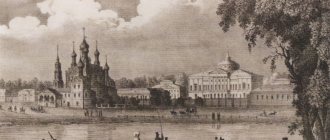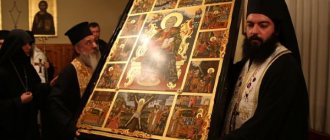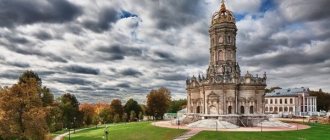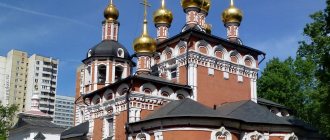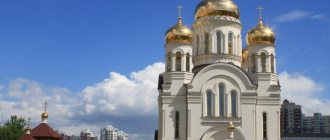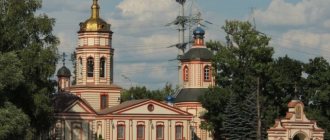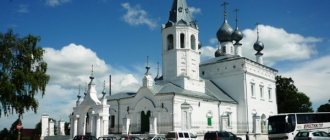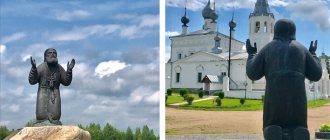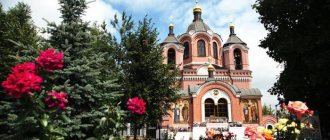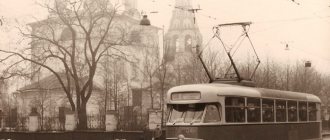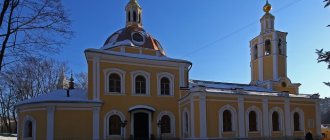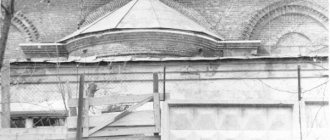"Save me, God!".
Thank you for visiting our website, before you start studying the information, please subscribe to our Orthodox community on Instagram, Lord, Save and Preserve † - https://www.instagram.com/spasi.gospodi/. The community has more than 60,000 subscribers. There are many of us like-minded people and we are growing quickly, we post prayers, sayings of saints, prayer requests, and timely post useful information about holidays and Orthodox events... Subscribe. Guardian Angel to you!
The Temple of the Kazan Mother of God in Kolomenskoye is a treasure of ancient Russian architecture. The church has been decorating Kolomenskoye for three and a half centuries. This is a masterpiece of Russian architecture and historical cultural heritage.
Church of the Beheading of John the Baptist in Kolomenskoye today
An amazingly beautiful temple dedicated to John the Baptist (the closest predecessor of Jesus Christ, who baptized the Savior in the waters of the Jordan River) was built in the village of Dyakovo (therefore it would be more correct to call it the Temple of the Beheading of John the Baptist in Dyakovo) and, according to many researchers, is considered older than the famous Church of the Ascension in the village of Kolomenskoye.
Not only the temple, but also its location can be considered unique. The first mentions of Kolomenskoye go back to 1339. In the spiritual charter of Ivan Danilovich Kalita there is a mention of Kolomenskoye, but there is not a word about the neighboring village of Dyakovo, so it is widely believed that Dyakovo arose later.
Temple of the Beheading of John the Baptist in Kolomenskoye
However, archaeological finds indicate the opposite. On the territory of Dyakovo there is a hill, during excavations of which traces of an ancient human settlement were discovered, dating back to approximately the 5th century. BC e.
When in the middle of the 19th century. Serious scientific research began on this area, called Dyakovo Settlement, then a whole cultural layer was discovered, which now exists in world historical science as a separate concept “Dyakovo culture”.
It was this place that was chosen for the construction of the temple, which was originally intended for royalty. Historical documents tell about the repeated presence of representatives of the royal family in the temple during divine services.
After the revolution, the temple was closed to parishioners. It was transferred to the museum department of the Main Science. In 1923, Kolomenskoye (including the temple in Dyakovo) was transferred to the status of a museum on the initiative of the famous architect Pyotr Baranovsky, who became its restorer and first director.
Further, the history of the temple developed as follows:
- In December 1991, after many years of inactivity, it was transferred to the Russian Orthodox Church.
- In 1992 it was deregistered and the building was transferred to the parish.
- The church officially reopened on September 11, 1992. From that time on, full-fledged parish life began.
- The restoration of the building, which began after the transfer, was completed in 2009.
- In the year of the celebration of the 850th anniversary of Moscow (1997), His Holiness Patriarch Alexy II toured the ancient churches of Moscow and served in them. The temple of the village of Dyakovo was also on this list.
- In September 2010 (on City Day), the temple was visited by Kirill, His Holiness the Patriarch of Moscow and All Rus', as well as Yuri Luzhkov (then mayor of Moscow).
Historical features
The Kazan Church in Kolomna has reached our time almost unchanged. The church itself with five domes, a hipped bell tower and its chapels have also been preserved. Under the cross of the central dome there is an inscription telling about the construction of the church on the very spot where a wooden temple was previously built in honor of the centenary of the conquest of Kazan. According to historical chronology, this version has a basis, because the Tatar capital was recaptured in 1552.
The wooden church that was previously located on this site was most likely the Kazan Church built in the 30s of the 17th century. It is mentioned in several historical documents . Some sources say that at one time there was a camp of False Dmitry II in these places, and it was he who built this temple. However, not all historians agree with this version.
Prophetic dream of Evdokia Adrianova
The “Sovereign” icon is the main shrine not only of the Kazan Church, but also one of the most highly revered miraculous images of the Blessed Virgin Mary in Orthodoxy. The veneration of the icon is associated with a new period in Russian history. As the legend says, one of the residents of the Bronnitsky district of Perervinskaya Sloboda, Evdokia Adrianova, repeatedly saw the same dream.
She dreamed of a snow-white temple, while she heard a demand to find a black icon and make it red. In the spring of 1917, in the village of Kolomenskoye, in the basement of the Ascension Church, an icon depicting the Mother of God was found. It had turned black from time and dampness. The icon depicted the Mother of God with the Child Christ sitting on her lap. In the hands of the Mother of God were the royal regalia - an orb and a scepter.
Icon "Sovereign"
At the same time, Tsar Nicholas II signed the abdication of the throne not only for himself, but also for Tsarevich Alexei, handing it over to his brother Mikhail Alexandrovich, the Grand Duke. And people living in Kolomenskoye and neighboring towns began to venerate the icon. According to many Orthodox Christians , the Mother of God guards the royal orb and scepter, symbolizing royal power and great Russia.
Historians attribute the image itself to the Constantinople, that is, Byzantine canon of icon painting. It is believed that it was written at the end of the 18th century. At the Moscow Alekseevsky Monastery there are art workshops in which the “Sovereign” Mother of God was restored. It turned out that the vestments of the Virgin Mary are depicted in red, as was said to Evdokia Adrianova in a dream.
During the Soviet era, the icon was kept for a long time in the storerooms of the Historical Museum in Moscow. In 1990, she was solemnly returned to the fold of the church. Today the original is in Kolomna in the Kazan Church.
Other shrines of the temple
In addition to the “Sovereign” icon, the temple contains:
Several valuable icons dating back to the 17th century are in the church iconostasis, consisting of five tiers. A revered copy (copy) of the “Sovereign” icon, known and revered throughout Russia, is in the same iconostasis. Statue of "Christ in Prison", made of wood and painted with oil paints. This unique work of art is located in the northern aisle of the church. Unfortunately, the name of the author of the shrine is unknown.
Nowadays, the Kazan Church is still active and is open to everyone throughout the year. Just like several centuries ago, divine services are held there. In 1910, the walls of the church were painted with scenes from the lives of saints and their faces.
History of construction
The exact date of construction of the temple and the reason why it was erected in honor of this church holiday are not known with certainty. There are several opinions on this matter.
Many scientists believe that the construction of the church was timed to coincide with the crowning of Ivan IV. And it was erected in honor of the saint, whom Ivan IV considered his patron. This version is the most common.
According to another version, the temple was built by Vasily III in the 30s of the 16th century. in honor of the birth of the heir Ivan Vasilyevich, later nicknamed the Terrible. The legend says that Vasily III, while on vacation in these places, received news of the birth of his son, which was brought by a messenger on August 29 (old style), on the feast of the beheading of John the Baptist.
In connection with this event, Vasily III gives the order to found a church in these places in honor of this holiday, and to name the newborn heir Ivan.
The third version has something in common with the second. According to scientists, the temple was built by Vasily III with a prayer for the granting of an heir to him. In addition, some researchers believe that the temple was originally dedicated not to the beheading, but to the conception of John the Baptist.
This assumption is based on the fact that Vasily III had no children in his marriage to his first wife Solomonia Yuryevna Saburova. The heir was born only in the second union with Elena Glinskaya.
The following facts can be considered indirect confirmation of this:
- the side chapel is dedicated to St. Anne - the mother of the Virgin Mary;
- another chapel is dedicated to the patron of the Kalita family, Metropolitan Peter, and may express the desire of the royal couple to grant such a miracle as the conception and birth of an heir;
- the temple also has a chapel dedicated to the saints Tsar Constantine and his mother Elena, which may indicate Elena Glinskaya’s appeal to her heavenly patroness with requests for conception.
There is also a 4th version, voiced in Soviet times by Wolfgang Wolfgangovich Kavelmacher, a classic of architectural restoration. He believed that the church was moved to Dyakovo from the old Vagankovo (now Pashkov’s house stands there).
The fact is that immediately after the crowning of Ivan IV, the wooden Vagankov Church of the Beheading of John the Baptist burned down in a strong fire. Therefore, the sovereign had to restore it. The site chosen for construction was a hill on the high right bank of the Moscow River, where the favorite residence of the Moscow tsars was located.
One way or another, there are no direct indications of the construction date.
Therefore, there are several possible dates:
- 1529 - this date is associated with the version of the prayer for an heir;
- 1547 – crowning of Ivan IV;
- 1554 – birth of Tsarevich Ivan Ivanovich, son of Ivan the Terrible.
The year of completion of construction is considered to be 1570.
Story
Kolomenskoye Park was the former residence of the royalty of the Russian state. The idea of building a church came to Tsar Mikhail Fedorovich after liberation from the Swedish-Polish invasion. But the cathedral was erected during the time of his son Alexei Mikhailovich, when the heir to the throne was born. In Kolomenskoye, in 1667, a new wooden palace was built, which, together with the erected temple, formed a single complex.
Some historical data indicate that the church was erected in honor of the centenary of the capture of Kazan, others that it was founded by Mikhail Fedorovich, and the illumination took place during the reign of his son.
A building was erected on the site of the Kazan Church, where False Dmitry II once hid. This is what prompted the king to make a monument to the events of past years, remove the old structure and build a new one.
The best article for you, go to: Temple “Joy of All Who Sorrow” on Ordynka
The changes did not affect the church tent structure, and it currently represents its original appearance. Under the cross there is an inscription that the temple was built on the site of a wooden church as a tribute to the victory over the Kazan principality a hundred years ago. Historical data matches. Kazan was conquered in 1552, and in 1669 Tsar Mikhail Fedorovich issued a decree on the veneration of the Blessed Virgin Mary. Construction was completed four years later.
After the death of Alexei Mikhailovich, the significance of the cathedral fades away. In the seventeenth century, Kolomenskoye ceased to be a state residence. In the second half of the nineteenth century, the summer palaces began to be removed, and the temple became a parish church.
In the twenties of the last century, the cathedral was closed and a museum was opened.
The church is currently open daily from 07:30 to 20:00. The schedule of services at the Kazan Church in Kolomenskoye is indicated at the entrance.
There is an adult baptismal font, a church Sunday school and a library.
Architect, exterior decoration, architectural ensemble
Such an unusual temple with an original architectural style can be considered the only one in Russia. At the same time, the names of the architects who built this miracle remain a mystery.
Architects of the temple
There is an opinion that the temple was built by two masters - Barma and Postnik, who later built St. Basil's Cathedral on Red Square.
Monument to the architects Barma and Postnik in Kazan
The composition, unusual for Russian architecture, allowed historians to put forward a version that the Cathedral of the Beheading of John the Baptist was the predecessor of St. Basil's Cathedral: the temple in Dyakovo is much smaller than the Cathedral of the Intercession of the Blessed Virgin Mary in Moscow, and looks like its miniature copy.
The connection between these temples was made by art historians and architectural historians. There is no written evidence of the continuity of the councils. However, there are similarities in the unusual architectural design, form, techniques and materials used. In addition, both churches are the only surviving multi-pillar ones, created in the mid-16th century.
Some researchers believe that the temple in Dyakovo is the creation of Italian architects. This version is supported by the existence of several sketches by Leonardo da Vinci, which depict just such a centric temple with 4 extreme drums and domes. It almost exactly repeats the architectural features of the Dyakovo Cathedral.
Architecture
The Church of the Beheading of John the Baptist in Kolomenskoye is a pillar-shaped structure. The center of the composition is an 8-sided pillar, the height of which reaches 34 m 50 cm. It is adjacent to 4 8-sided aisles 17 m high, which are connected by a bypass covered gallery. The western gallery is two-tiered with an open belfry in the center.
The entire building looks like a monolith, however, unlike the eastern aisles, the western aisles are separated from the main volume by narrow passages.
The central volume, designed with a semicircular apse, houses the main temple. The aisles do not have pronounced apses, but the temple looks like a three-apse structure due to the placement of the prisms of the side pillars to the eastern side of the temple.
The paintings of the cathedral have not survived to this day. Due to the fact that the internal space is not enough for Eastern Christian iconography, experts believe that the temple was not painted in a traditional manner (perhaps it was fragmentary or of an ornamental nature).
However, in the 19th century. the building was still painted both inside and outside. But over time, the painting was removed, giving the interior a whitewashed look that may have been consistent with the original appearance.
The artistic image of the building has no analogues, but experts attribute it to a clear “Russian-European” version, a number of features of which are inherent in Renaissance architecture.
Cemetery on the temple grounds
Closely adjacent to the temple building was a large cemetery, which extended hundreds of meters far beyond the temple fence. There were more than 200 burials with beautiful white stone tombstones. However, at the end of the 70s. Just before the Olympics, the museum received the status of a reserve, and the cemetery (after the reburial of the remains) was destroyed.
Now you can see up to 80 historical tombstones that were here earlier and moved from different places as museum exhibits, the oldest of which dates back to the 14th century.
In 2014, a worship cross was erected on the territory of the cemetery with the inscription: “In memory of all clergy and laity buried in the Dyakovskoye cemetery.”
Kazan Church in Moscow
The appearance of the church on Red Square in Moscow is due to the fact that in Rus' they began to venerate the icon of the Kazan Mother of God outside the diocese of Kazan. Thus, the list from the icon accompanied the second zemstvo militia , which was formed in Yaroslavl and sent to Moscow to fight the Polish invaders.
In 1796, in the “Guide to Historical Moscow” there was a mention that the very first temple of the icon of the Kazan Mother of God, at that time still made of wood, was erected in 1652. The guidebook says that the church was built at the expense of Prince Dmitry Pozharsky, who led the militia against the Polish-Lithuanian occupiers.
One of the most important temples in the capital
There is a widespread belief that the Church of Our Lady of Kazan was erected in honor of the expulsion of Polish invaders from Moscow. In earlier sources that have survived to this day, nothing is said about this temple, which allegedly burned down in 1634, about the reasons for the construction of the church. Tsar Mikhail Fedorovich allocated funds for the construction of a stone church in order to house the “Lubyanka” copy of the Kazan icon.
In 1636, the temple was consecrated by Patriarch Joasaph I. 11 years later, a new chapel was added to the church in honor of the Kazan wonderworkers Guria and Barsanuphius. In the temple architecture of the 17th century, traditionally, the quadruple bases of bell towers were built on the northwestern side of the church. The tented bell tower of the Kazan Cathedral was built according to these canons. Despite its small size, the church became one of the most important churches in Moscow. The rector of the cathedral occupied one of the leading positions among the Moscow clergy.
Further history of the cathedral
The history of the construction of the Kazan Cathedral is very complicated. At the end of the 60s of the 18th century, it was reconstructed at the expense of Princess Dolgorukova. During the renovation, due to the impossibility of restoration, the chapel of Saints Gurias and Barsanuphius was demolished.
After the reconstruction of the upper shopping rows, the view of the Kazan Cathedral from Red Square was practically blocked. The lower floor of the bell tower was equipped with benches. At the beginning of 1802, at the insistence of Metropolitan Platon, the old tented bell tower was dismantled. By 1805, a two-tier bell tower was built in a new location, which in 1865 was converted into a three-tier one.
The barbarity of the French soldiers
In 1865, the facades were decorated in the style of the temple classics, and the cathedral became similar to all refectory churches located in Russia. Metropolitan Leonty, who visited this cathedral, said that the temple is no different from a simple rural church.
During the Patriotic War of 1812, French troops occupied Moscow. As the famous playwright of that time A.A. Shakhovskoy testifies, French soldiers brought a dead horse into the altar of the Kazan Church. The corpse was placed in the very place where the throne, which was thrown away, was located. Archpriest Moshkov managed to hide the icon of Our Lady of Kazan. In July 1918, the main shrine of the Kazan Cathedral - a copy of the icon of the Mother of God, which was considered miraculous, was stolen.
Kazan Cathedral in the twentieth century
In the 30s of the twentieth century, the famous architect and restorer P. D. Baranovsky led the large-scale reconstruction and restoration of the cathedral. It is believed that after the work, the church regained its original appearance. But many historians are skeptical about this version, since there is very little documentary material left. The information that has survived to this day is very contradictory. For example, the hipped bell tower, demolished in 1802, looks different in the surviving images.
Under the leadership of Baranovsky, ancient kokoshniks and supposed decorative decoration of the walls were restored . However, in 1936 the Kazan Cathedral was demolished . It became possible to restore it in the future only thanks to a successful coincidence of circumstances. Baranovsky, who learned about the upcoming demolition of the temple, ordered absolutely all external and internal measurements of the church and its chapel.
Re-creation of the temple
The Kazan Cathedral was recreated in the 90s of the twentieth century. The restoration was initiated by the Moscow branch of the All-Russian Society for the Protection of Historical and Cultural Monuments. The author of the architectural project was a student of P. D. Baranovsky - O. I. Zhurin. After completion of construction, artists from Bryansk and Palekh painted the cathedral in the canonical Orthodox manner.
On the day of the celebration of the appearance of the Kazan Icon of the Mother of God, the newly rebuilt temple was consecrated by Patriarch Alexy II. Today it is operational and services are held in it. You can visit the church daily from 9−00 to 19−00. The restored temple of the icon of the Kazan Mother of God is revered not only by believers, but is also popular among tourists because of its amazing beauty.
In addition to the two described temples, on the territory of Moscow there are several churches dedicated to Our Lady of Kazan, among them are:
- in Izmailovo;
- in Uzkoy;
- in Orlov;
- in Losinoostrovskaya.
Interior decoration
The interior walls are practically unpainted. There are paintings only on the portals of the side galleries.
To the left of the entrance to the main temple there is a niche where, judging by photographs from the 19th century, there was a large fresco “The Head of the Forerunner on a Platter.” At the moment, in the niche there are icons with images of the new martyrs of the Russian Church.
There are 6 chapels in the temple. Each dome is a separate altar. On the ground floor of the main church there is a main altar in memory of the beheading of John the Baptist. In smaller volumes are the chapels of the 12 Apostles and the Conception of St. Anne on one side, the Conception of John the Baptist and the Moscow Saints Peter, Alexy and Jonah on the other.
On the second floor there is also a chapel erected in honor of Saints Equal to the Apostles Constantine and Helen.
In an era of persecution
At the time of the massive destruction of churches, the Church of the Kazan Icon of the Mother of God in Kolomenskoye almost did not stop its work: it was closed only for two years at the beginning of the Great Patriotic War. But since then services have been held regularly.
Interior of the Kazan Church in Kolomenskoye
Two clerics were glorified as new martyrs:
Hieromartyr Sergius of the Resurrection served here as a priest for nine years until his arrest; Hieromartyr Leonty Strotsyuk served as a deacon in this church for almost twenty years.
It is noteworthy that at the beginning of the 20th century in Kolomenskoye there was another church in the name of the Great Martyr George the Victorious. However, in 1929 it was closed. The Kazan believers were able to defend.
Temple shrines
The Church of the Beheading of John the Baptist in Kolomenskoye has its own shrines.
These are the icons:
- of the Venerable Head of John the Baptist on a platter;
- Kazan Icon of the Virgin Mary;
- Hieromartyr Sergius Dyakovsky.
Icon of the Hieromartyr Sergius Dyakovsky (Sergei Voskresensky)
Hieromartyr Sergius Dyakovsky (Sergei Voskresensky) from 1920 until its closure (until 1923) was the last rector of the cathedral. He was arrested and exiled to the north, where he suffered martyrdom. He was canonized on December 26, 2001. An icon was painted from his life, which is considered one of the shrines of the temple.
Building style
This is a pillarless five-domed temple with a circular gallery, arched connections and staircases. Many designs served a decorative role. The walls of the temple were decorated with rich paintings, they were draped with expensive carpets and materials, and the icons were framed with towels. The floor covering of the cathedral was felt.
The best article for you, go to: Alexander Nevsky Temple at MGIMO
The Church of the Icon of the Mother of God in Kolomenskoye was assigned the role of a family church at the palace chambers. The cathedral was connected by a gallery to the palace of Alexei Mikhailovich, and it was convenient. The length of the passages to the palace was 50 meters and the width was 3 meters. When the royal palace was moved to another place, the cathedral became the church monastery of Kolomenskoye.
The dignity of the building lies not in the originality of the architecture, but in the perfection of the style of Russian Orthodox architecture.
Shrines:
- miraculous image of the Mother of God “Sovereign”,
- list of the image of the Kazan Icon of the Mother of God,
- holy relics of Sergei Voskresensky and Leonty Strotsyuk,
- An ancient sculpture of Christ in prison is, as it were, an atypical attribute for Russian churches.
Social work, everyday life
On weekdays and on Saturdays, divine liturgies are celebrated in the church, prayer services and memorial services are served, baptisms and weddings take place.
The community takes care of psychiatric hospital No. 15, which is located on Kashirskoye Highway. In one of its buildings there is a beautiful hospital church in honor of Tsarevich Alexei, in whose name services are held on Fridays. 8.00 – start of services.
After restoration, the temple regained its amazing sound, which is considered one of the best in Moscow. Therefore, the church constantly hosts concerts of sacred music.
Excellent acoustics are associated with the presence of golosniks in the building - clay jugs embedded in the walls. They are located in 3 rows in the upper part of the temple, in a row of 8 voice boxes in the side towers, as well as in the belt of kokoshniks outside the building.
History[edit]
The construction of the Church of the Kazan Icon of Our Lady was conceived by the first tsar of the Romanov dynasty, Mikhail Fedorovich, in memory of the deliverance from the Polish-Lithuanian intervention in 1612. However, the temple was built already during the reign of Alexei Mikhailovich and dedicated to the birth of his son and heir - Tsarevich Dmitry.
The brick two-story building is located on a high basement, rectangular in plan with two staircases protruding far from the north and south with porches leading to the second tier of the building. The northern porch, connected to a separately located, square-shaped, hipped bell tower, is a single example in 17th-century architecture.
The church, performing the functions of a house temple, was connected at the level of the gallery of the second tier of the southern facade by a covered passage with the mansions of the queen of the new wooden palace of Alexei Mikhailovich. The covered passage was described as follows by Polish ambassadors who visited Kolomenskoye in 1671 - “at the beginning, the church is made of stone with porches on both sides in which there are windows, half a quarter arshin wide, bridges lined with felt for warmth and soft walking.” The length of the passages was about 50 m and the width was about 3 m.
After construction, the Kazan Church was painted, richly decorated with a variety of fabrics and carpets. The metal floor of the central part and the flanked floor of the aisles were lined with felt for warmth. The icons on the walls were decorated with shrouds and towels; many icons were kept in carved icon cases.
With the transfer of the royal palace to a new location in the 60s of the 18th century, the church became the parish church of Kolomenskoye.
During Soviet times, in 1941-1942, the temple was closed, then services resumed and never stopped.
Consecration of the lower church in honor of the “Sovereign” Icon of the Mother of God on July 27, 2012.
Service schedule, operating hours
The Church of the Beheading of John the Baptist in Kolomenskoye can be visited from 12.00 to 17.00 on Saturday, Sunday, and on all civil weekends. During services, the temple is also open to the public.
Services in the church are conducted in Church Slavonic. Morning services are held at 8 a.m. (until approximately 11.30) on Saturdays, Great and Patronal holidays, as well as on days of remembrance of especially revered saints and icons of the Mother of God.
Evening services are held on Saturdays and on High Holidays. Starts at 18:00 and lasts until approximately 21:00.
Opening hours
Temple opening hours:
- Monday - from 8 to 12 o'clock.
- Tuesday, Wednesday, Thursday - from 8 to 16.
- Friday, Saturday - from 8 to 19.
- Sunday - from 7 to 19 (in summer - from 8 to 30).
Worship times:
- On weekdays at 8 o'clock the liturgy is held, at 17 o'clock the all-night prayer is read.
- On Sundays a late liturgy is added, starting at 9.40.
The temple is located at the address: Moscow, Kolomensky district, Andropov Avenue, 31.
What's in the surrounding area, how to get there?
Regular visitors (but not parishioners) consider this working church difficult to access due to the fact that it is located deep in the reserve and far from transport stops.
You can get there by metro, bus, trolleybus:
| Transport | Stop name |
| Metro | "Kolomenskaya" or "Kashirskaya" |
| Trolleybus No. 67 | "Museum Kolomenskoye" |
| Buses No. 287, 291 |
From metro stations to the temple you should walk on average about 20 minutes.
Bus stop "Kolomenskoye Museum"
A wooden staircase leads to the temple through the forest, which ends at a fence. To get to the temple grounds, you should walk along the fence to the main gate, after crossing which visitors find themselves in an ancient cemetery located almost under the walls of the cathedral.
Interesting facts about the temple, legends
In Kolomenskoye, the Church of the Beheading of John the Baptist is one of the most mysterious in Russia.
There is little accurate information about him, but there are plenty of interesting facts, mysteries and legends:
- For example, the temple goes around an unfrozen stream. Its temperature in any weather is 4 °C. This amazing natural phenomenon is explained by the fact that near the Moscow River there are springs that formed during the Jurassic period. They make their way from great depths, so they do not freeze even when the river is frozen.
- The Church of the Beheading of John the Baptist in Kolomenskoye is located near the Golosov Ravine, where various anomalies occur. This can also be explained from a scientific point of view: a geological fault has formed in this area, as a result of which a powerful magnetic field is observed.
- There is a legend that under the Moscow River there is a wide tunnel through which even by chariot you can get from Dyakovo to the Nikolo-Perervinsky Monastery, located on the other side of the river.
The Temple of the Beheading of John the Baptist is unique and mysterious. According to many experts, it may become the answer to an even greater mystery. The hill in Kolomenskoye, on which the temple building is located, is dotted with voids. Perhaps the library of Ivan the Terrible, which has been wanted for decades, will be found there.
Author: Irina Zhuravka
Temple in Kolomenskoye - beginning
The history of the creation of the temple in Kolomenskoye dates back to the 17th century during the reign of Mikhail Romanov. According to information that has survived to this day, a wooden church was built in Kolomenskoye in the 30s of the 17th century. Her throne was consecrated in honor of one of the main shrines of Rus' - the icon of Our Lady of Kazan. One chapel is in honor of the early Christian saint Averky of Hierapolis, and the second is in honor of Demetrius of Thessalonica, the great martyr.
In 1645, Alexei Mikhailovich ascended the royal throne. During his reign, repairs and restoration of the Kolomna Church began. In 1648, the king’s first child was born, who was christened in honor of St. Demetrius of Thessalonica. In connection with this event, a stone chapel of the same name was added to the Kazan Church, and three years later a bell tower was erected, which has a hipped top.
Connection of the church with the royal palace
Towards the end of the 17th century, a palace was being built in Kolomenskoye for the Tsar, which was an architectural masterpiece of Russian architecture and admired with its beauty. The Church of the Icon of the Kazan Mother of God was connected to the royal palace by a covered passage. After that, she essentially became a brownie. The entire royal family prayed there. The temple and its chapels were completed four years later.
Numerous foreign ambassadors who came to Tsar Alexei Mikhailovich at his residence were amazed by the beauty of the erected buildings. What they admired most was not the temple itself, but the passage to the palace. It was 50 meters long and 3 meters wide. The floor of the passage was covered with felt to preserve heat and make it comfortable to walk on.
In the next article you will read a description of the Church of the Intercession of the Blessed Virgin Mary in Medvedkovo.
An example of Russian architecture
The Kazan temple was built according to the canons of Russian architecture of the 17th century. It is a two-story rectangular building. The church is located on a high basement; two porches with stairs approach it from the southern and northern sides. They lead to the top floor. The stairs on the second floor are connected by a covered walkway (gallery), which has access to the bell tower.
The facades of the church are decorated with small windows. The corners of the temple are decorated with double pilasters (false columns), which serve as a kind of basis for a wide cornice. The upper part of the building is also decorated with small windows and a decorative three-row cornice.
Upper tier and prayer thrones
The facade of the upper tier and the five towers on which the domes are installed are decorated with kokoshniks. There are two chapels adjacent to the church on the southern and northern sides. Each of them also has a tower with a dome. The bell tower was built in a traditional style. It consists of two quadrangles of different sizes. An octagonal tower with a domed top was built on top of them.
According to the chronicles, the Kolomna parish was previously decorated with beautiful icons in gold and silver frames, as well as icon cases carved from valuable wood. The temple had expensive church utensils, covers, shrouds and carpets. For the Tsar and his wife Maria Ilyinichna (and then another wife, Natalya Kirillovna), special throne places for prayer were created and richly decorated. Those close to royalty were allowed to visit the temple iconostases for this purpose, and the retinue was allowed to pray in the refectory.
